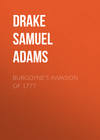Читать книгу: «Nooks and Corners of the New England Coast», страница 2
The mountains have been traversed again and again by fire, destroying not the wood alone, but also the thin turf, the accumulations of years. The woods are full of the evidences of these fires in the charred remains of large trees that, after the passage of the flames, have been felled by tempests. At a distance of five miles the present growth resembles stubble; on a nearer approach it takes the appearance of underbrush; and upon reaching the hills you find a young forest repairing the ravages made by fire, wind, and the woodman's axe. "Fifty years ago," said Mr. Somes, "those mountains were covered with a dark growth." Cedars, firs, hemlocks, and other evergreens, with a thick sprinkling of white-birch, and now and then a clump of beeches, make the principal base for the forest of the future on Mount Desert – provided always it is permitted to arrive at maturity. Hitherto the poverty or greed of the inhabitants has sacrificed every tree that was worth the labor of felling. In the neighborhood of Salisbury's Cove there are still to be seen in inaccessible places, trees destined never to feel the axe's keen edge.
Mine host of the village tavern, Daniel Somes, or "Old Uncle Daniel," as he is known far and near, is the grandson of the first settler of the name who emigrated from Gloucester, Massachusetts, and "squatted" here – "a vile phrase" – about 1760. Abraham Somes built on the little point of land in front of the tavern-door, from which a clump of shrubs may be seen growing near the spot. Other settlers came from Cape Cod, and were located at Hull's and other coves about the island. I asked my landlord if there were any family traditions relative to the short-lived settlement of the French, or traces of an occupation that might well have set his ancestors talking. He shook his gray head in emphatic negative. Had I asked him for "Tam O'Shanter" or the "Brigs of Ayr," he would have given it to me stanza for stanza.
There are few excursions to be made within a certain radius of Somesville that offer so much of variety and interest as that on the western side of the Sound, pursuing, with such wanderings as fancy may suggest, the well-beaten road to South-west Harbor. It is seven miles of hill and dale, lake and stream, with a succession of charming views constantly unfolding themselves before you. And here I may remark that the roads on the island are generally good, and easily followed.
The map may have so far introduced the island to the reader that he will be able to trace the route along the side of Robinson's Mountain, which is between the road and the Sound, with two summits of nearly equal height, rising six hundred and forty and six hundred and eighty feet above it. At the right, in descending this road, is Echo Lake, a superb piece of water, having Beech Mountain at its foot. You stumble on it, as it were, unawares, and enjoy the surprise all the more for it. Broad-shouldered and deep-chested mountains wall in the reservoirs that have been filled by the snows melting from their sides. There are speckled trout to be taken in Echo Lake, as well as in the pond lying in Somesville. Of course the echo is to be tried, even if the mount gives back a saucy answer.
Next below us is Dog Mountain. It has been shut out from view until you have uncovered it in passing by the lake. Dog Mountain's eastern and highest crest is six hundred and eighty feet in the air. How much of resemblance it bears to a crouching mastiff depends in a great measure upon the imagination of the beholder:
Ham. "Do you see yonder cloud that's almost in shape of a camel?"
Pol. "By the mass, and 'tis like a camel indeed."
Ham. "Methinks it is like a weasel."
Pol. "It is backed like a weasel."
Ham. "Or like a whale?"
Pol. "Very like a whale."
Between Dog and Brown's Mountain on its eastern shore the Sound has forced its way for six or seven miles up into the centre of the island. At the southern foot of Dog Mountain is Fernald's Cove and Point, the supposed scene of the attempted settlement by the colony of Madame the Marchioness De Guercheville. Mr. De Costa has christened Brown's Mountain with the name of Mansell, from Sir Robert Mansell, vice-admiral in the times of James I. and Charles I. The whole island was once called after the knight, but there is a touch of retributive justice in recollecting that the English, in expelling the French, have in turn been expelled from its nomenclature.
Turning now to what Prescott calls "historicals" for enlightenment on the subject of the colonization of Mount Desert, it appears that upon the return of De Monts to France he gave his town of Port Royal to Jean de Poutrincourt, whose voyage in 1606 along the coast of New England will be noticed in future chapters. The projects of De Monts having been overthrown by intrigue, and through jealousy of the exclusive rights conferred by his patent, Madame De Guercheville, a "very, charitable and pious lady" of the court,13 entered into negotiation with Poutrincourt for the founding of Jesuit missions among the savages. Finding that Poutrincourt claimed more than he could conveniently establish a right to, Madame treated directly with Du Guast, who ceded to her all the privileges derived by him from Henry IV. The king, in 1607, confirmed all except the grant of Port Royal, which was reserved to Poutrincourt. The memorable year of 1610 ended the career of Henry, in the Rue de la Ferronerie. In 1611 the fathers, Père Biard and Enemond Masse, of the College d'Eu, came over to Port Royal with Biencourt, the younger Poutrincourt. During the next year an expedition under the auspices of Madame De Guercheville was prepared to follow, and, after taking on board the two Jesuits already at Port Royal, was to proceed to make a definitive settlement somewhere in the Penobscot.
The colonists numbered in all about thirty persons, including two other Jesuit fathers, named Jacques Quentin and Gilbert Du Thet.14 The expedition was under the command of La Saussaye. In numbers it was about equal to the colony of Gosnold.
La Saussaye arrived at Port Royal, and after taking on board the fathers, Biard and Masse, continued his route. Arriving off Menan, the vessel was enveloped by an impenetrable fog, which beset them for two days and nights. Their situation was one of imminent danger, from which, if the relation of the Père Biard is to be believed, they were delivered by prayer. On the morning of the third day the fog lifted, disclosing the island of Mount Desert to their joyful eyes. The pilot landed them in a harbor on the east side of the island, where they gave thanks to God and celebrated the mass. They named the place and harbor St. Sauveur.
Singularly enough, it now fell out, as seven years later it happened to the Leyden Pilgrims, that the pilot refused to carry them to their actual destination at Kadesquit,15 in Pentagoët River. He alleged that the voyage was completed. After much wrangling the affair was adjusted by the appearance of friendly Indians, who conducted the fathers to their own place of habitation. Upon viewing the spot, the colonists determined they could not do better than to settle upon it. They accordingly set about making a lodgment.16
The place where the colony was established is obscured as much by the relation of Biard as by time itself. The language of the narration is calculated to mislead, as the place is spoken of as "being shut in by the large island of Mount Desert." The Jesuit had undoubtedly full opportunity of becoming familiar with the locality, and his account was written after the dissolution of the plantation by Argall. There is little doubt they were inhabiting some part of the isle, as Champlain in general terms asserts. Meanwhile the grassy slope of Fernald's Point gains many pilgrims. The brave ecclesiastic, Du Thet, could not have a nobler monument than the stately cliffs graven by lightning and the storm with the handwriting of the Omnipotent. The puny reverberations of Argall's broadsides were as nothing compared with the artillery that has played upon these heights out of cloud battlements.
During the summer of 1613, Samuel Argall, learning of the presence of the French, came upon them unawares, and in true buccaneer style. A very brief and unequal conflict ensued. Du Thet stood manfully by his gun, and fell, mortally wounded. Captain Flory and three others also received wounds. Two were drowned. The French then surrendered.
Argall's ship was called the Treasurer. Henri de Montmorency, Admiral of France, demanded justice of King James for the outrage, but I doubt that he ever received it. He alleged that, besides killing several of the colonists and transporting others as prisoners to Virginia, Argall had put the remainder in a little skiff and abandoned them to the mercy of the waves. Thus ended the fourth attempt to colonize New England.
Argall, it is asserted, had the baseness to purloin the commission of La Saussaye, as it favored his project of plundering the French more at his ease, the two crowns of England and France being then at peace. He was afterward knighted by King James, and became a member of the Council of Plymouth, and Deputy-governor of Virginia. During a second expedition to Acadia, he destroyed all traces of the colony of Madame De Guercheville. It is pretty evident he was a bold, bad man, as the more his character is scanned the less there appears in it to admire.
Brother Du Thet, standing with smoking match beside his gun, was worthy the same pencil that has illustrated the defense of Saragossa. I marvel much the event has not been celebrated in verse.
An enjoyable way of becoming acquainted with Somes's Sound is to take a wherry at Somesville and drift slowly down with the ebb, returning with the next flood. In some respects it is better than to be under sail, as a landing is always easily made, and defiance may be bidden to head winds.
One of the precipices of Dog Mountain, known as Eagle Cliff, has always attracted the attention of the artists, as well as of all lovers of the beautiful and sublime. There has been much search for treasure in the glens hereabouts, directed by spiritualistic conclaves. One too credulous islander, in his fruitless delving after the pirate Kidd's buried hoard, has squandered the gold of his own life, and is worn to a shadow.
When some one asked Moll Pitcher, the celebrated fortune-teller of Lynn, to disclose the place where this same Kidd had secreted his wealth, promising to give her half of what was recovered, the old witch exclaimed, "Fool! if I knew, could I not have all myself?" Kidd's wealth must have been beyond computation. There is scarcely a headland or an island from Montauk to Grand Menan which according to local tradition does not contain some portion of his spoil.
Much interest is attached to the shell heaps found on Fernald's Point and at Sand Point opposite. There are also such banks at Hull's Cove and elsewhere. Indian implements are occasionally met with in these deposits. It is reasonably certain that some of them are of remote antiquity. Williamson states that a heavy growth of trees was found by the first settlers upon some of the shell banks in this vicinity.17 Associated with these relics of aboriginal occupation is the print in the rock near Cromwell's Cove, called the "Indian's Foot." It is in appearance the impression of a tolerably shaped foot, fourteen inches long and two deep. The common people are not yet freed from the superstitions of two centuries ago, which ascribed all such accidental marks to the Evil One.
In my progress by the road to South-west Harbor, I was intercepted near Dog Mountain by a sea-turn that soon became a steady drizzle. This afforded me an opportunity of seeing some fine dissolving views: the sea-mists advancing, and enveloping the mountain-tops, cheated the imagination with the idea that the mountains were themselves receding. A storm-cloud, black and threatening, drifted over Sargent's Mountain, settling bodily down upon it, deploying and extending itself until the entire bulk disappeared behind an impenetrable curtain. It was like the stealthy approach and quick cast of a mantle over the head of an unsuspecting victim.
Very few were abroad in the storm, but I saw a nut-cracker and chickadee making the best of it. I remarked that under branching spruces or fir-trees the grass was still green, and the leaves of the checker-berry bright and glossy as in September. On this road admirable points of observation constantly occur from which to view the shifting contours of Beech and Western mountains, with the broad and level plateau extending along their northern baseline far to the westward. Retracing with the eye this line, you see a little hamlet snugly ensconced on the hither slope of Beech Mountain, while the plateau is rounded off into the bluffs rising above Echo Lake.
South-west Harbor is usually the stranger's first introduction to Mount Desert. The approach to it is consequently invested with peculiar interest to all who know how to value first impressions. Its neighborhood is less wild and picturesque than the eastern shores of the island, but Long Lake and the western range of mountains are conveniently accessible from it; while, by crossing or ascending the Sound, avenues are opened in every direction to the surpassing charms of this favored corner of New England.
At South-west Harbor the visitor is usually desirous of inspecting the sea-wall, or cheval-de-frise of shattered rock, that skirts the shore less than three miles distant from the steamboat landing. And he may here witness an impressive example of what the ocean can do. An irregular ridge of a mile in length is piled with shapeless rocks, against which the sea beats with tireless impetuosity.
Fog is the bane of Mount Desert. Its frequency during the months of July and August is an important factor in the sum of outdoor enjoyment. Happily, it is seldom of long continuance, as genial sunshine or light breezes soon disperse it.
There is, however, a weird sort of fascination in standing on the shore in a fog. You are completely deceived as to the nearness either of objects or of sounds, though the roll of the surf is more depended upon by experienced ears than the fog-bell. In sailing near the land every one has noticed the recoil of sounds from the shore, as voices, or the beat of a steamer's paddles. Coming through the Mussel Ridge Channel one unusually thick morning, the fog suddenly "scaled up," discovering White Head in uncomfortable proximity. The light-house keeper stood in his door, tolling the heavy fog-bell that we had believed half a mile away. Our pilot gave him thanks with three blasts of the steam-whistle.
Off the entrance to the Sound are several islands – Great Cranberry, of five hundred acres; Little Cranberry, of two hundred acres; and, farther inshore, Lancaster's Island, of one hundred acres. The eastern channel into the Sound is between the two last named. Duck Island, of about fifty acres, is east of Great Cranberry; and Baker's, on which is the light-house, is the outermost of the cluster.
The cranberry is indigenous to the whole extent of the Maine sea-board. It grows to perfection on the borders of wet meadows, but I have known it to thrive on the upland. The culture has been found very remunerative in localities less favored by nature, as at Cape Cod and on the New Jersey coast. Some attempts at cranberry culture have recently been made with good success at Lemoine, on the main-land, opposite Mount Desert. Blue-berries are abundant on Mount Desert. I saw one young girl who had picked enough in a week to bring her seven dollars. Formerly they were sent off the island, but they are now in good demand at the hotels and boarding-houses. In poorer families the head of it picks up a little money by shore-fishing. He plants a little patch with potatoes, dressing the land with sea-weed, which costs him only the labor of gathering it. His fire-wood is as cheaply procured from the neighboring forest or shore, and in the autumn his wife and children gather berries, which are exchanged for necessaries at the stores.
At the extreme southerly end of Mount Desert is Bass Harbor, with three islands outlying. It is landlocked, and a well-known haven of refuge.
CHAPTER III.
CHRISTMAS ON MOUNT DESERT
"You should have seen that long hill-range,
With gaps of brightness riven —
How through each pass and hollow streamed
The purpling light of heaven – "
Whittier.
Having broken the ice a little with the reader, I shall suppose him present on the most glorious Christmas morning a New England sun ever shone upon. "A green Christmas makes a fat church-yard," says an Old-country proverb; this was a white Noël, cloudless and bright. I saw that the peruke of my neighbor across the Sound, Sargent's Mountain, had been freshly powdered during the night; that the rigging of the ice-bound craft harbored between us was incased in solid ice, reflecting the sunbeams like burnished steel. The inscription on mine host's sign-board was blotted out by the driving sleet; the brown and leafless trees stood transfigured into objects of wondrous beauty. I heard the jingle of bells in the stable-yard and the stamping of feet below stairs, and then
"I heard nae mair, for Chanticleer
Shook off the pouthery snaw,
And hail'd the morning with a cheer,
A cottage-rousing craw."
The roads from Bar Harbor and from North-east Harbor unite within a short distance of Somesville, and enter the village together. Within these highways is embraced a large proportion of those picturesque features for which the island is famed. In this area are the highest mountains, the boldest headlands, the deepest indentations of the shores. It is not for nothing, therefore, that Bar Harbor has become a favorite rendezvous of the throngs
"That seek the crowd they seem to fly."
On Christmas-day the road to Bar Harbor was an avenue of a winter palace more sumptuous than that by the Neva. Every spray of the dark evergreen trees was heavily laden with a light snow that plentifully besprinkled us in passing beneath the often overreaching branches. The stillness was unbroken. Blasted trees – gaunt, withered, and hung with moss like rags on the shrunken limbs of a mendicant – were now incrusted with ice-crystals, that glittered like lustres on gigantic candelabra. On the top of some rounded hill there sometimes was standing the bare stem of a blasted pine, where it shone like the spike on a grenadier's helmet. It was a scene of enchantment.
I saw frequent tracks where the deer had come down the mountain and crossed the road, sometimes singly, sometimes in pairs, and in search, no doubt, of water. The foot-prints of foxes, rabbits, and grouse were also common. During the day I met an islander who told me he had shot a fat buck only a day or two before, and that many deer were still haunting the mountains. Formerly, but so long ago that only tradition preserves the fact, there were black bear and moose; and traces of beaver are yet to be seen in their dams and houses. Red foxes and mink, and occasionally the black fox, greatly valued for its fur, are taken by the hunters. In order to make the roads interesting to nocturnal travelers, rumor was talking of a panther and a wolf that had been seen within a short time.
In the day when these coasts were stocked with beaver, its skin was the common currency of the country, as well of the Indians as of the whites. It was greatly prized in Europe, and constituted the wealth of the savages of northern New England, who were wholly unacquainted with wampum until it was introduced among them by the Plymouth trading-posts on the Penobscot and Kennebec.
The wigwam of a rich chief would be lined with beaver-skins, and, if he were very rich, his guests were seated on packs of it. Then, as now, a suitor was not the less acceptable if he came to his mistress with plenty of beaver. It was the Indians' practice to kill only two-thirds of the beaver each season, leaving a third for increase. The English hunters killed all they found, rapidly exterminating an animal which the Indian believed to be possessed of preternatural sagacity.
Our road, after crossing a northern spur of Sargent's Mountain, which lifts itself more than a thousand feet above the sea, led on over a succession of hills. Beyond Sargent's, Green Mountain stood unveiled, with what seemed the tiniest of cottages perched on its summit. Ere long Eagle Lake lay outstretched at the right, but it was in the trance of winter. The painter, Church, whose favorite ground lay about due south, christened the lake, doubtless with a palmful of water from its own baptismal font. The roadway is thrown across its outlet where the timbers of an old mill, that some time ago had gorged itself with the native forest, lay rotting and overthrown.
Green Mountain overpeers all the others. On its summit you are fifteen hundred and thirty-five feet higher than the sea. On this account it was selected as a landmark for the survey of the neighboring coasts. It is not difficult of ascent, as the mountain road built by the surveyors is considered practicable for carriages nearly or quite to the top. I had anticipated ascending it, but the new-fallen snow rendered walking difficult, and I was forced to content myself with viewing it from all sides of approach.
An acquaintance with the sierras of either half of the continent exercises a restraining influence in presence of an upheaval comparatively slight, yet it is only in a few favored instances that one may stand on the summits of very high mountains and look down upon the sea. New England, indeed, boasts greater elevations at some distance from her sea-coast, among which the Mount Desert peaks would appear dwarfed into respectable hills. On a clear day, and under conditions peculiarly favorable, a distant glimpse of Katahdin and of Mount Washington may be had from the crest of Green Mountain. In summer the little house is open for the refreshment of weary but adventurous pilgrims.
Here I would observe that the island nomenclature is painfully at variance with whatever is suggestive of felicitous rapport with its natural characteristics. The name of Mount Desert, it is true, is singularly appropriate; but then it was given by a Frenchman with an eye for truth in picturesqueness. In the year 1796, when the north half of the island was formed into a township, it was called, with sublimated irony, Eden. Green Mountain is not more green than its neighbors. At the Ovens I saw plenty of yeast, but not enough to leaven the name. Schooner Head is not more apposite.
Just before coming into Bar Harbor there is an excellent opportunity of observing the cluster of islands to which it owes existence. These are the Porcupine group, and beyond, across a broad bay, the Gouldsborough hills appeared in a Christmas garb of silvery whiteness. The Porcupine Islands, four in number, lie within easy reach of the shore, Bar Island, the nearest, being connected with the main-land at low ebb. On Bald Porcupine General Fremont has pitched his head-quarters. It was the sea that was fretful when I looked at the islands, though they bristled with erected pines and cedars.
The village at Bar Harbor is the sudden outgrowth of the necessities of a population that comes with the roses, and vanishes with the first frosts of autumn. It has neither form nor comeliness, though it is admirably situated for excursions to points on the eastern and southern shores of the island as far as Great Head and Otter Creek. A new hotel was building, notwithstanding the last season had not proved as remunerative as usual. I saw that pure water was brought to the harbor by a wooden aqueduct that crossed the valley on trestles, after the manner practiced in the California mining regions, and there called a flume. There is a beach, with good bathing on both sides of the landing, though the low temperature of the water in summer is hardly calculated for invalids.
From Bar Harbor, a road conducts by the shore, southerly, as far as Great Head, some five miles distant. After following this route for a long mile, as it seemed, it divides, the road to the right leading on five miles to Otter Creek, and thence to North-east Harbor, seven miles beyond. Excursions to Great Head, and to Newport Mountain and Otter Creek, should occupy separate days, as the shores are extremely interesting, and the scenery unsurpassed in the whole range of the island.
In pursuing his explorations at or near low-water mark, it will be best for the tourist to begin a ramble an hour before the tide has fully ebbed. The tides on this coast ordinarily rise and fall about twelve feet, and in winter, as I saw, frequently eighteen feet. Hence the advance and retreat of the waves is not only rapid, but leaves a broader margin uncovered than in Massachusetts Bay, where there is commonly not more than eight feet of rise and fall. In many places along the arc of the shore stretching between Bar Harbor and Great Head, the ascent to higher ground is, to say the least, difficult, and, in some instances, progress is forbidden by a beetling cliff or impassable chasm. As time is seldom carefully noted when one is fairly engaged in such investigations, it is always prudent first to know your ground, and next to keep a wary eye upon the stealthy approach of the sea.
There is a pleasant ramble by the shore to Cromwell's Cove; but here onward movement is arrested by a cliff that turns you homeward by a cross-path through the fields to the road, after having whetted the appetite for what is yet in reserve.
Schooner Head is reached by this road in about four miles from Bar Harbor, and three from the junction of the Otter Creek road. I walked it easily in an hour. The way is walled in on the landward side by the abrupt precipices of Newport Mountain, in the sheer face of which stunted firs are niched here and there. Very much they soften the hard, unyielding lines and cold gray of the crags; the eye lingers kindly on their green chaplets cast about the frowning brows of wintry mountains. This morning all were Christmas-trees, and the ancients of the isle hung out their banners to greet the day.
Emerging from the woods at a farm-house at the head of a cove, a foot-path leads to the promontory at its hither side. It is thrust a little out from the land, sheltering the cove while itself receiving the full onset of the sea. An intrusion of white rock in the seaward face is supposed by those of an imaginative turn to bear some resemblance to a schooner; and, in order to complete the similitude, two flag-staffs had been erected on the top of the cliff. At best, I fancy it will be found a phantom ship to lure the mariner to destruction.
I did not find Schooner Head so remarkable for its height as in the evidences everywhere of the crushing blows it has received while battling with storms. "Hard pounding this, gentlemen; but we shall see who can pound longest," said the Iron Duke at Waterloo. Here are the rents and ruins of ceaseless assault and repulse. The ocean is slowly but steadily advancing on both sides of the continent; perchance it is, after all, susceptible of calculation how long the land shall endure.
I clambered among the huge blocks of granite that nothing less than steam could now have stirred, although they had once been displaced by a few drops of water acting together. A terrible rent in the east side of the cliff is locally known as the Spouting Horn. Down at its base the sea has worn through the rock, leaving a low arch. At the flood, with sufficient sea on, and an off-shore wind, a wave rolls in through the cavity, mounts the escarpment, and leaps high above the opening with a roar like the booming of heavy ordnance. These natural curiosities are not unfrequent along the coast. There is one of considerable power at Cape Arundel, Maine, that I have heard when two miles from the spot. Unfortunately for the tourist, these grand displays are usually in storms, when few care to be abroad; undoubtedly, the outward man may be protected and the inward exalted at such times. Some of the more adventurous go through the Horn: I went around it.
I saw here a few ruminant sheep gazing off upon the sea. What should a sheep see in the ocean?
On the farther side of the cove is a sea-cavern that has the reputation of being the finest on the island. Within its gloomy recesses are rock pools of rare interest to the naturalist. In proper season they will be found inhabited by the sea-anemone and other and more debatable forms of animal life. Some of these aquaria I have seen are of marvelous beauty, recalling the lines,
"Full many a gem of purest ray serene
The dark unfathomed caves of ocean bear."
Lined with mother-of-pearl and scarlet mussels, resting on beds of soft sponge or purple moss-tufts, these fairy grottoes are the favorite retreat of King Crab and his myrmidons, of the star-fish and sea-urchin. Twice in every twenty-four hours the basins are refilled with pure sea-water, than which nothing can be more transparent. Strange that these rugged crags, where the grasp of man would be loosened by the first wave, should be instinct with life! It required some force to detach a mussel from its bed, and you must have recourse to your knife to remove the barnacles with which the smoother rocks are incrusted. John Adams, when he first saw the sea-anemone, compared it, in figure and feeling, to a young girl's breast.
Mount Desert has been familiar to two of the greatest of American naturalists. When Audubon was preparing his magnificent "Birds of America," he visited the island, and I have no doubt the report of his rifle was often heard echoing among the mountains or along the shores. Agassiz was also here, interrogating the rocks, rapping their stony knuckles with his hammer, or pressing their gaunt ribs with playful familiarity. Audubon died in 1851. Agassiz is more freshly remembered by the present generation, to whom he made the pathway of Natural Science bright by his genius, and pleasant, by his genuine, whole-hearted bonhomie.



















